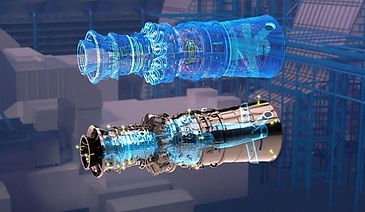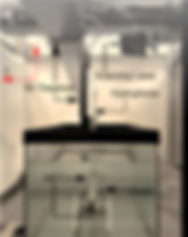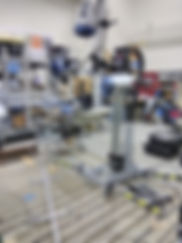Some Research Projects
Dynamic data driven modeling of tracked order vibration in Rolls Royce engine (PhD Thesis)
-
Tracked order vibration has been the industry standard to monitor vibrations in Rolls Royce engine
-
Challenging to develop system-level physics based models for tracked order vibrations that can accurately account for the effect of current as well as the historical operational conditions
-
Lack of baseline model hinders accurate diagnosis as well as prognosis.
-
Current thesis work designs and implements a data-driven framework using wavelet-based dynamic mode decomposition in conjunction with multiscale detrended cross-correlation to model the tracked order vibration.
-
Evaluated the performance of our in-house methodology (WDMD) with off the shelf machine learning framework and WDMD was found to be 10% more efficient in capturing the overall trend.
-
Improved modeling accuracy with interesting findings
-
Because of the confidential nature of the work, results cannot be uploaded currently.
-
Research Collaborators: Rolls Royce Derby, Rolls Royce Germany
Publications
-
Krishnan, M., Jin, R., Sever, I. A., and Tarazaga, P. A., 2019, "Data Based Modeling of Aero Engine Vibration Responses", IMAC XXXVII A conference and Exposition on Structural Dynamics, FL, Jan 28-31. (https://link.springer.com/chapter/10.1007/978-3-030-12676-6_34)
-
Krishnan, M., Gugercin, S., Sever, I., and Tarazaga, P. A., 2020, "Dynamic data driven modeling of aero engine response," IMAC XXXVIII A Conference and Exposition on Structural Dynamics, TX, Feb 10-133. (https://link.springer.com/chapter/10.1007/978-3-030-47638-0_30)
-
Krishnan, M., Sever, I., and Tarazaga, P. A., 2020, "Determining interdependencies and causation of vibration in aero engines using multiscale cross-correlation analysis," IMAC XXXVIII A Conference and Exposition on Structural Dynamics, TX, Feb 10-13. (https://link.springer.com/chapter/10.1007/978-3-030-47638-0_29)
-
Krishnan, M., Gugercin,S, & Tarazaga, P. A. “Wavelet based Dynamic mode decomposition. (Manuscript ready for submission to MSSP)
-
Krishnan, M., Sever, I., and Tarazaga, P. A., 2021, “Wavelet based dynamic mode decomposition for aero engine vibration”, AIAA, Scitech – 2021 (Manuscript submitted for clearance).
-
Krishnan, M., Jin, R., Sever, I. A., Gugercin,S. & Tarazaga, P. A. "Data driven modeling of Aero Engine Vibration Responses". (Manuscript preparation)
-
Krishnan, M., Gugercin,S, Sever, I. A.,. & Tarazaga, P. A. “Wavelet based DMD for modeling the tracked order vibration response using a cascading dynamical systems approach". (Manuscript preparation)
Patent:
Cascading dynamical system with WDMD and Delay DMD towards modeling tracked order vibration response (Planning)




Data-driven approach to investigate the interaction of Anechoic Structural Traveling Waves with fluid Environment
-
A mechanical wave is generated as a result of an oscillating body interacting with the well-defined medium and it propagates through that medium transferring energy from one location to another.
-
The ability to generate and control the motion of the mechanical waves through the finite medium opens up the opportunities for creating novel actuation mechanisms.
-
Waves with desired characteristics are generated by the excitation of piezoelectric elements through coupled system dynamics.
-
This project is aimed at developing a data-driven model for the interaction of anechoic structural traveling wave with a fluid environment.
-
The data-driven methodology is developed using experimentally obtained Frequency response data using the responses collected by a hydrophone of a beam excited under water using PZT patches as shown in the figure.
-
Vector-Fitting (VF) algorithm is used to build a state-space model of the dynamical system from steady state FRF data
-
The results of the work are summarized in the video.
Publications
-
Krishnan, M., Malladi, V. S., & Tarazaga, P. A. (Under Review in Mechanical systems and Signal Processing). Leveraging a data-driven approach to simulate and experimentally validate aMIMO multiphysics vibroacoustic system

Experimental Data-Driven Determination of Dispersion Characteristics of Structures
-
Collaborated in developing a data-driven technique to estimate dispersion relations that are experimentally tedious
-
Utilized easy-to-measure Frequency Response Functions (FRFs) to develop a numerical model of the structure under test.
-
Constructed group velocity curves through a series of numerical simulations.
-
Validated the experimental data-driven approach by analytical calculation for a one-dimensional homogeneous beam
-
Designed and performed an experiment using 3D laser vibrometer to measure steady-state flexural as well as longitudinal FRF's

Project |03

Publications
- Malladi V.V.N.S., Albakri., Krishnan. M., Tarazaga P.A., and Gugercin S., (Under Review in Mechanical Systems and Signal Processing) "Estimating Experimental Dispersion Curves from Steady-StateFrequency Response Measurements"
Investigation of propagation of Traveling waves in a buckled structure
-
Utilize the buckling property of structures to generate high amplitude traveing waves
-
Dynamically exciting buckled structure to continuously switch between its two potential well to create high amplitude traveling wave which can be used for propagation or drag reduction
-
Experimentally validation using computer vision and laser vibrometer.
-
Resulted in a spinoff project: Manipulating the structure using smart materials to induce flutter


Real-time damage detection of structures
-
Structural damage detection involving condition assessment, fault diagnosis and prognosis of civil, mechanical and aerospace infrastructure has garnered significant attention and a wealth of literature exists in this area
-
Traditional offline damage detection schemes have disadvantages
-
This work proposes a real-time damage detection framework using time-varying auto regressive(TVAR) modeling in conjunction with recursive principal component analysis (RPCA) to detect spatio-temporal structural damage in real time.

Publications
- Krishnan, M., Bhowmik, B., Hazra, B., & Pakrashi, V. (2018). Real time damage detection using recursive principal components and time varying auto-regressive modeling. Mechanical Systems and Signal Processing, 101, 549-574.
- Bhowmik, B., Krishnan, M., Hazra, B., & Pakrashi, V. (2019). Real-time unified single-and multi-channel structural damage detection using recursive singular spectrum analysis. Structural Health Monitoring, 18(2), 563-589.
- Krishnan, M., Bhowmik, B., Tiwari, A. K., & Hazra, B. (2017). Online damage detection using recursive principal component analysis and recursive condition indicators. Smart Materials and Structures, 26(8), 085017.
- Bhowmik, B., Krishnan, M., Hazra, B., & Pakrashi, V. (2017). Online damage detection using recursive principal component analysis. Procedia engineering, 199, 2108-2113.

Miniature underwater robot: Traveling wave
-
The purpose of this work is to develop a state of the art miniature underwater robot using the traveling wave generated in the fins as the propulsion mechanism.
-
Research colleague: Dr.Sriram Malladi, Sheyda Davaria, Dr. Pablo Tarazaga
